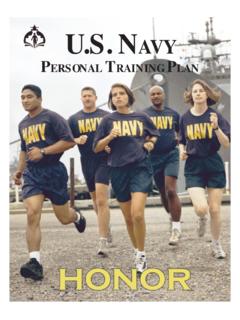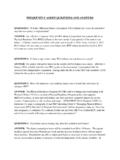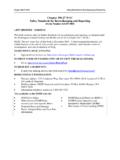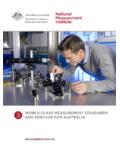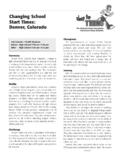Transcription of FINAL NOFFS Introduction - navy-prt.com
1 Introductionnavy operational Fitness Series navy Operational Fueling & Fitness Series Table of Contents The navy Operational Fitness and Fueling Series ( NOFFS ) Project Overview Project Introduction Functional Performance = Operational Performance NOFSS Project Development Team Emphasizing Physical Training and Injury Prevention Running Mileage Body Movement Skills Focus Group & Findings Operational Fitness Feedback from Sailors Operational Fueling Feedback from Sailors Product Review: Operational Fitness Series Program Design Methodology Pillar Preparation Movement Preparation Strength Cardiovascular Fitness Recovery Training Program Introduction Movement Library 2 2 3 4 5 6 6 8 9 9 10 11 11 12 13 14 15 16 17 - 47 2 The navy Operational Fitness and Fueling Series Project Project Introduction The navy Operational Fitness and Fueling Series Project ( NOFFS ) provides the navy with a best in class physical fitness and nutrition performance resource that provides guidance to Sailors and to navy health and fitness professionals.
2 The navy Operational Fitness and Fueling Series instructs individuals how to physically train effectively and safely, and how to make healthy nutrition choices in both shore-based and operational environments. As the navy is called to intensify operational tempo based on current world-wide mission requirements, it is imperative for Sailors to be physically fit. Physical fitness of Sailors is an essential and critical component of operational readiness and meeting deployment schedules. Sailor resiliency and durability are primary goals of the development and distribution of the NOFFS . The purpose of the navy Operational Fitness Series is to provide a complete physical training program that will eliminate the guesswork for the individual Sailor that is participating in her/her personal physical training program.
3 The navy health and fitness professional that is interested in obtaining a readily prepared comprehensive and biomechanically balanced individual or group physical training program. The NOFFS project goals are to: 1: Improve operational performance. 2: Provide foundational and performance nutrition guidance. 3: Decrease the incidence/severity of musculoskeletal physical training related injuries. The navy Operational Fitness and Fueling Series provides Sailors with an evidence-based performance tool that will address injury prevention by physically training operational job movement patterns. Rather than focusing specifically on the physical readiness test (PRT), the product will emphasize how to specifically improve the functional performance of a Sailor during daily operations including; lifting, pushing, pulling, carrying, aerobic/anaerobic demands, body movement skills with balance, agility and coordination.
4 The focus of the product is to optimize operational physical performance and fueling for Sailors while preserving navy combat power. 3 Functional Performance = Operational Performance: Does the Training Relate to the Demands on the Job? The operational environment places a unique demand of physiological and mechanical stress on to the human body. This demand requires a systematic approach to physical preparation to ensure personnel are operationally efficient and can sustain a productive, healthy career. There is a consummate paradigm shift in physical development from a traditional fitness model of isolated, single joint resistance to an archetype in integrated training systems based on movement including: Restoring Movement Training Movement Fueling Movement The NOFFS represents this training system as a professional medium to take care of the navy s greatest asset: its people.
5 Training Movements that prepare Sailors for the demands of operational performance. 4 NOFFS Project Development Team: A comprehensive cooperative navy project team was assembled for the purpose of developing the NOFFS . The primary project team consists of the following organizations: Center for Personal and Professional Development (CPPD) the project manager; TYCOMS including COMNAVSUBFOR, COMNAVSURFOR, and COMNAVAIRFOR (over 750 Sailors provided input for the development of the NOFFS ); Commander Naval Installations Command (CNIC) MWR Fitness, Nutrition, & Deployed Forces Program; navy Supply Command (NAVSUP) Nutrition Program, OPNAV 135 Physical Readiness Division; navy Safety Center; Naval Leadership Command; and Bureau of Medicine and Surgery (BUMED) assets: Clinical Care and Public Health(M3/5 CCPH), SG Specialty Advisors, and navy and Marine Corps Public Health Center.
6 Center for Personal and Professional Development (CPPD) serves as the project manager for the navy Operational Fitness and Fueling Series. CPPD promotes and institutionalizes a culture of fitness in the navy . It is the responsibility of the CPPD to serve as the central authority for navy training for leadership, professional, and personal development training and support. Physical fitness/human performance is a primary component of the CPPD s health and wellness program. CPPD supports the navy s workforce by providing tools, knowledge, and information to support the character growth, professional development, and personal competency of Sailors. These tools promote personal development and improve personal readiness which in turn helps accomplish the navy s mission. To augment these efforts, athletes Performance Institute (API), recognized within the professional sports human performance industry as a leading expert in developing training programs that produce results, is working directly with navy physical fitness and nutrition experts.
7 SAFETY NAVSUP Nutrition athletes Performance Institute Medical BUMED, SG Specialty Advisors; NMCPHC, MTF HP & Medical Center Programs PERSONNEL QUALIFICATIONS OPNAV 135 CNIC Waterfront Fitness Operational Nutrition MWR Fitness FITBOSS SAILORS Over 750 Shore-based & Deployed TRAINING Human Performance NETC, RTC, TSC, CLS, NSTC, CPPD, NETPDTC Operational Fitness and Fueling Project Team 5 APAZ APLA APFL API has an unmatched track record and history of efficiently and ethically improving professional/elite athletes performance. Additionally, API has extensive experience and knowledge of the Armed Forces community and the specialized needs of this warrior culture. The mission of API is to provide the finest performance methods, specialists and facilities seamlessly integrated to efficiently and ethically enhance our athletes performance.
8 Through this mission, API and the navy have specific goals that focus on; career productivity, performance enhancement, career longevity, injury prevention, motivation through education, sustainable strategies for success, and most importantly, achieving results. API is able to execute this mission and achieve these goals through the athletes ' Performance Training Systems (APTS). The APTS represents the world s leading Professional Sports Model (PSM) for the optimization of human performance in all training sectors and sports. The APTS was utilized to build the navy Operational Fitness and Fueling Series. Emphasizing Physical Training Injury Prevention Injuries impose a greater ongoing negative impact on the health and readiness of the Armed Forces than any other category of medical complaint during peacetime & combat (Am J.)
9 Prev Med, 2000, 18 (3S), p 16.) Injuries represent the leading health problem of military personnel across the spectrum of health from deaths and disabilities, to hospitalization and outpatient treatment (Jones et al. 1999; Jones and Amoroso 2000). Training-related (overuse) injuries have been identified as the leading cause of clinic visits and have a very real impact on the readiness of the Force due to limited duty assignments (Jones et al. 1999; Jones et al. 2000). Conservative estimates of time Service members are given physical activity restrictions are upwards of 25 million limited duty days per year for all three Services combined. These Service members are unable to perform their full duties and as a consequence many are unable to deploy. Most of the overuse injuries sustained in a military environment come from the cumulative effect of physical training.
10 The DoD Military Injury Prevention Priorities Working Group stated in 2006 that physical training and sports injuries are of particular concern. Decreasing injuries is likely to have the greatest impact on military readiness. The Defense Safety Oversight Council (DSOC) suggests that the greatest reduction of lost duty days due to injuries across DoD may be achieved via mitigation efforts focused specifically on sports-and physical training related injuries. DSOC, DoD Military Injury Prevention Priorities Working Group: Leading Injuries, Causes, and Mitigation Recommendations, Two key areas of risk that have been identified by the navy concerning injury and the approach to injury prevention are; Reducing running volume and developing body movement skills. 6 Running Mileage There is a growing body of military and civilian research that shows that high running volume significantly increases the risk for lower extremity injury.

